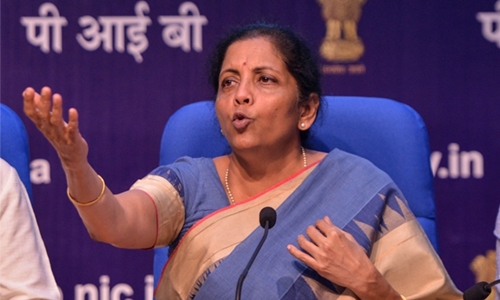India’s big ‘bank’ theory
India announced a series of mergers involving 10 stateowned banks yesterday, as it moves to strengthen the sector and ensure stronger balance sheets to boost lending and revive economic growth. The mergers, which cut to 12 the total number of state-owned banks, from 27 in 2017, are the first since Prime Minister Narendra Modi’s government won re-election in May. His government has vowed to clean up the banking sector and reduce the number of state-run banks.
Finance Minister Nirmala Sitharaman said Oriental Bank of Commerce and United Bank would be merged with New Delhi-headquartered Punjab National Bank, creating India’s second-largest lender after State Bank of India. The government also announced that two lenders based in southern India, Canara Bank and Syndicate Bank, would be amalgamated. Besides, Andhra Bank and Corporation Bank are to merge with Union Bank, while Indian Bank will be merged with Allahabad Bank.
“We’re trying to build the NextGen banks,” Sitharaman told a news conference. In 2017, the government merged State Bank of India with its associate banks, and this year, it merged Bank of Baroda with some smaller peers. The four new banks will hold business worth around 55.8 trillion rupees ($781 billion), or about 56 per cent of the Indian banking industry, Bloomberg News reported.
The government will also inject a combined 552.5 billion rupees into the new entities: PNB (Rs16,000 crore), Union Bank of India (Rs11,700 crore), Bank of Baroda (Rs7000 crore), Indian Bank ( Rs2500 crore), Indian Overseas Bank ( Rs3800 crore), Central Bank ( Rs3300 crore), UCO Bank ( Rs2100 crore), United Bank ( Rs1,600 crore) and Punjab and Sind Bank ( Rs750 crore). ANI said Bank of India and Central Bank of India will continue as Individual entities. Indian Overseas Bank, UCO Bank, Bank of Maharastra and Punjab and Sindh Bank will also continue to operate on their own.
“Gross non-performing assets have come down from Rs 8.65 crore to Rs 7.95 lakh crore,” said Sitharaman. “Special agencies have been formed to monitor loans above Rs 250 crore to avoid Nirav Modi like situation.” All PSU banks will now have a non-executive chairman, a position earlier existed only in State Bank of India. The public sector banks will have to appoint a Chief Risk Officer, who will be provided market-level compensation. Longer-term will be given to directors on management committees to ensure continuity.
Meanwhile, India’s economic growth slowed for the fifth straight quarter in the Aprilto-June period to 5.0 per cent, government figures showed yesterday. It compared with growth of 5.8pc in the last quarter and came in below predictions of 5.7pc by analysts. Sameer Narang, chief economist at the Bank of Baroda said he was hopeful that reform measures announced this month by Modi’s newly re-elected government would give the economy a boost in the coming quarters.
Finance Minister Nirmala Sitharaman recently revealed several measures to help the economy, including bringing forward a $10-billion liquidity lifeline for credit-shy banks and rolling back an extra levy on equity sales that had spooked foreign investors. Rating agency Moody’s revised India’s GDP growth forecast to 6.2pc from a previous estimation of 6.8pc for the financial year 2019-20.
Related Posts

